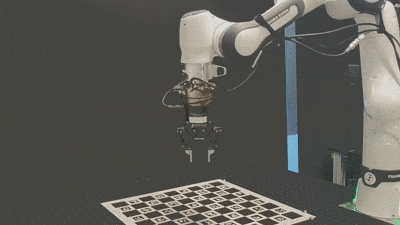Robot Arm Kinematic Calibration
Simple Python Library for Kinematic Calibration of Robot Arms
Everybody wants their robot to move precisely and accurately, especially in the context of object manipulation where a slight position error can lead to undesired outcomes (e.g., crashes). However, common serial robot arms often exhibit inaccuracies in their kinematic models: the actual structure of the robot is not the same as the nominal model defined by the manufacturer. This discrepancy leads to inaccuracies in motion planning, collision avoidance, and many other tasks.
I developed a Python library that refines the kinematic parameters of serial robot arms using a state-of-the-art POE-based method described in this paper. By leveraging end-effector observations (either as positions or full poses), this tool iteratively optimizes the robot model to account for discrepancies between the nominal and actual kinematics. I used this library to perform kinematic calibration on a Franka Research 3 robot, enabling it to perform low-tolerance object placement tasks.

Key Features
- Easy Setup:
Calibrate any serial robot with revolute joints with minimal setup. Many popular platforms like Franka robots, Kinova Jaco, UR 3/5/10 robots, Kuka LBR, Fetch, are supported out-of-the-box. The interface provided by the Robotics Toolbox makes integrating custom URDF modes a one-line matter (see example below). - Minimal Parametrization:
Identifies only the minimally required parameters, yielding maximal convergence speed. - Flexible Data Integration:
The input calibration data can be either end-effector point positions or the full end-effector pose. To accomodate various setups (e.g., motion capture systems, laser trackers, or cameras), the library is abstracted away from the data source. - Convenient Output:
Easily generate joint definitions directly usable in URDF files, boosting the accuracy of downstream tools like ROS and MoveIt.
A Minimal Example For a URDF Robot Model
Here’s a glimpse of how straightforward it is to perform kinematic calibration of a custom robot using this library:
import roboticstoolbox as rtb
from RobotKineCal import SerialRobotKineCal
#Load a custom robot model (A Kinova Gen3 in this case)
robot_model = rtb.ERobot.URDF(Path(__file__).parents[1] / 'Examples' / 'gen3.urdf')
#Calibrate (assuming configurations and observed_ee_poses are defined)
cal = SerialRobotKineCal(robot_model, ee_name=robot_model.ee_links[0].parent.name)
cal.set_observations(configurations, observed_ee_poses)
result = cal.solve()
#Print URDF joint definitions that can be directly used to update the robot's URDF file.
cal.print_urdf_joint_definitions()
In this example, the library processes your data and iteratively adjusts the kinematic parameters, ensuring that your robot’s internal model aligns perfectly with real-world measurements. The complete example can be found here: Calibration from URDF.
Curious to see more? Explore the full project on GitHub and let me know if the library is helpful to your work!